In the 1970s, North Anna Dam created Lake Anna — a reservoir designed to provide cooling water for the North Anna Power Station. Its two sides have two water temperatures — cool and hot. The hot side is where water is discharged after cooling the station’s two nuclear reactors.
The cool side is open to the public and is one of the most popular lakes in Virginia for watersports like boating, swimming, and fishing. The hot side is private and only open to residents, maintenance staff, and local authorities. Because the hot side tends to be a few degrees warmer all year long, it is often used for longer during the year.
You may find a few snakes at Lake Anna, and most will slither off before you get a chance to see them! Let’s discover a few snakes that live around Lake Anna.
Northern Watersnake (Nerodia sipedon)
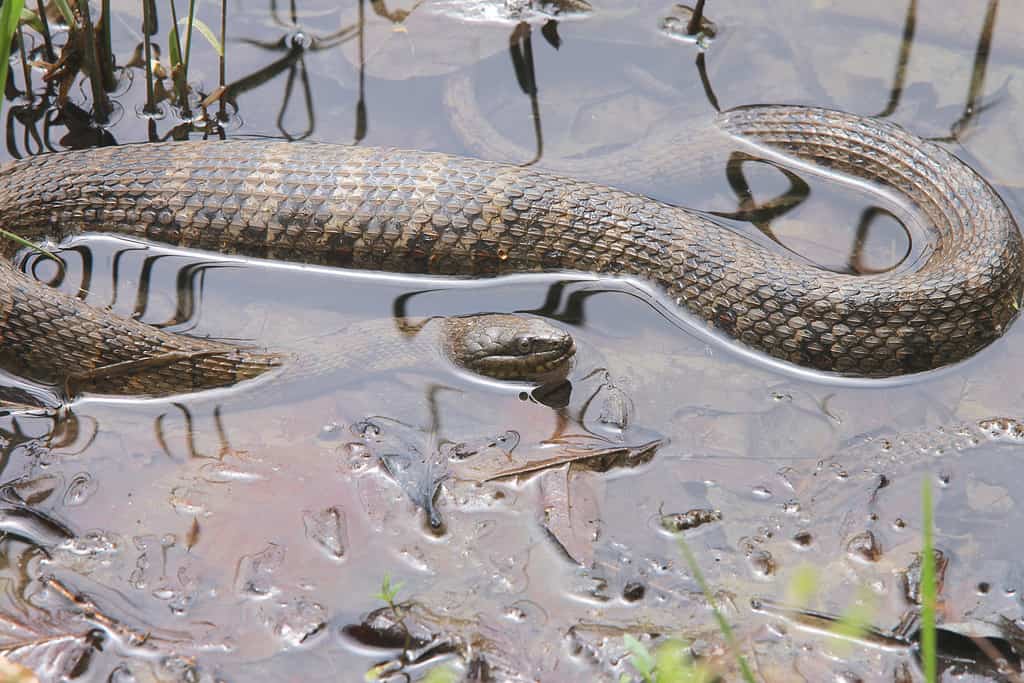
Northern watersnake’s eyes are set a little higher on top of their heads.
©iStock.com/NajaShots
Often confused for cottonmouths, northern watersnakes are harmless. Plus, there are no cottonmouths at Lake Anna. Virginia’s cottonmouths are only in the far west, east, and south –leaving central Virginia out of their range.
Northern watersnakes are nonvenomous fish and frog eaters. They spend hours dangling from branches and rock outcrops over the water, watching for a meal to swim underneath. These snakes use a mouth full of razor-sharp teeth to grab slippery food before swallowing it whole. As with most watersnakes, northern watersnakes are highly defensive and quick to bite when cornered. However, if you give the snake a little space, it is more than happy to slither off into the waters of Lake Anna.
Eastern Worm Snake (Carphophis amoenus)

Worm Snakes typically have dark tops and lighter-colored undersides
©Jason Patrick Ross/Shutterstock.com
Native to the eastern United States, eastern worm snakes are small nonvenomous snakes that spend their days under rotten logs and tree stumps. They are about 11 inches long as adults and mainly eat earthworms.
Around Lake Anna, they are most likely to find shelter under moist areas where earthworms might be hiding. Eastern worm snakes use a spine-like scale at the end of their tail to help pin their prey before swallowing it.
Eastern Ratsnake (Pantherophis alleghaniensis)
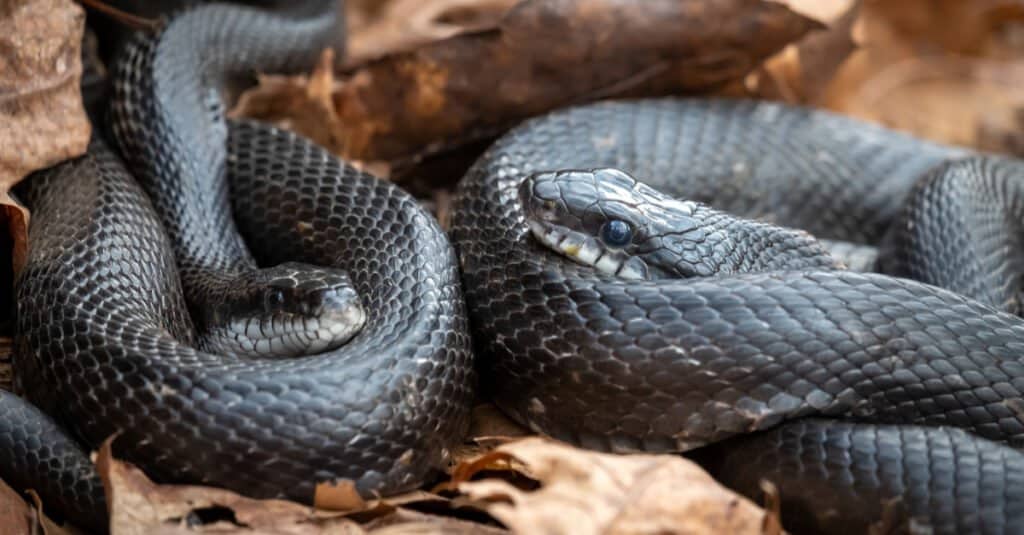
Eastern ratsnakes lose their juvenile pattern and become nearly black as adults.
©samray/Shutterstock.com
The Eastern rat snake is one of the longest snake species in North America — the record is over seven feet long. These serpentine troublemakers are excellent climbers, often searching the trees for birds and rodents. Some people find them sneaking through their garage rafters or climbing walls.
These harmless but feisty snakes eat rats, mice, small birds, and other small prey animals. Eastern ratsnakes usually turn almost solid black as adults, with a white chin and blotchy stomach. Around Lake Anna, you will probably find them searching the habitat for food, as they are active diurnal hunters.
Red-bellied Snake (Storeria occipitomaculata)
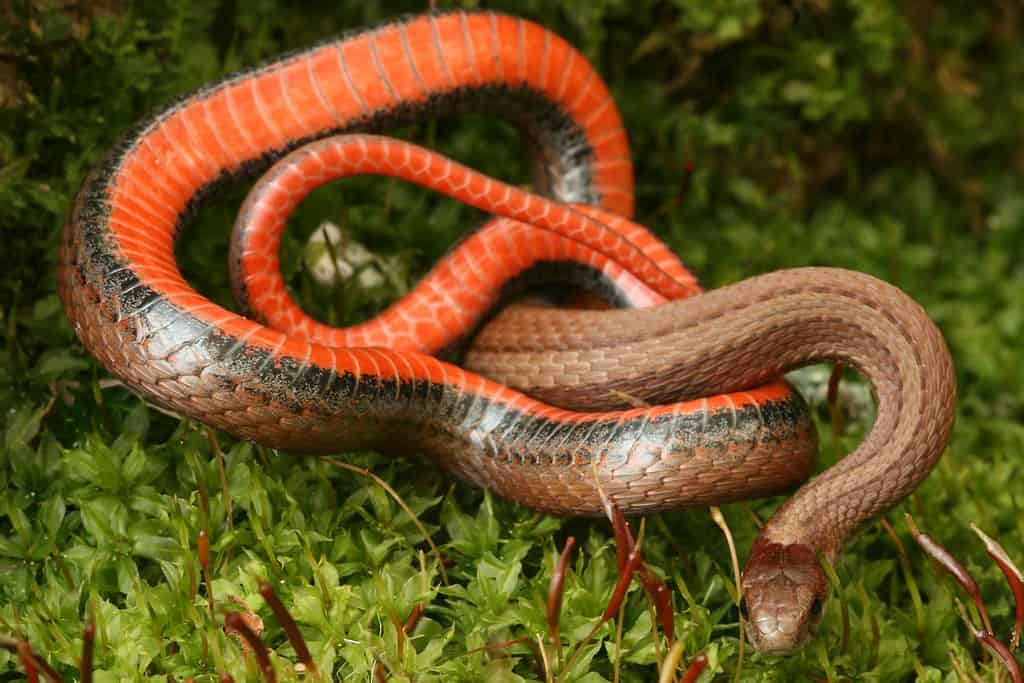
Red-bellied snakes are cousins to Dekay’s brownsnakes, inhabiting many of the same areas.
©Kevin Collison/Shutterstock.com
This species is small and not often seen outside of its moist home under leaf litter, rocks, logs, wood piles, and abandoned ant mounds for warmth. Red-bellied snakes eat slugs, snails, and other small arthropods, like many other small snake species. They have a red or orange belly with brown, black, or gray dorsal color and generally stay smaller than 10 inches.
These snakes are harmless and relatively docile when captured, almost never biting anyone.
Ring-necked Snake (Diadophis punctatus)
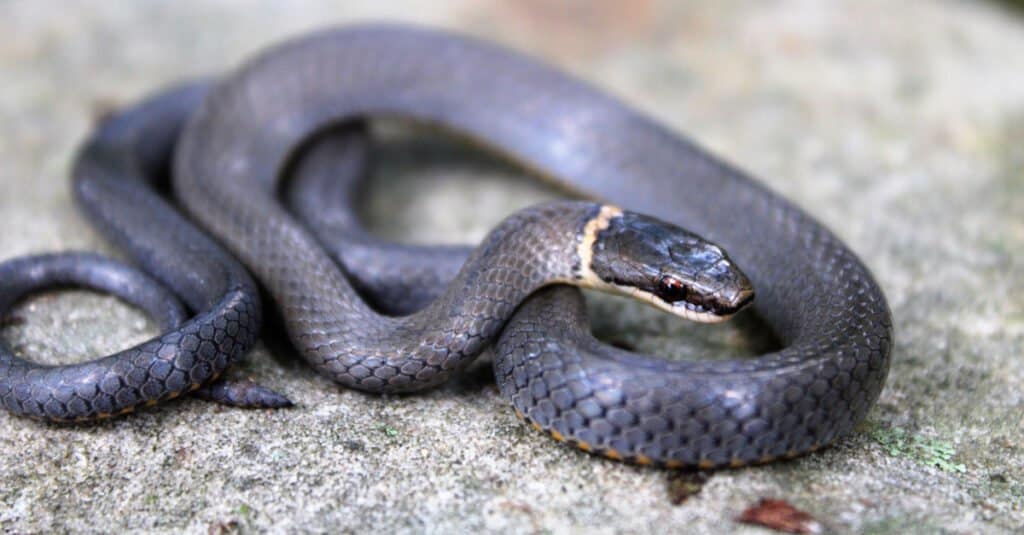
Ring-necked snakes (Diadophis punctatus) are nocturnal and hide under rotten logs or leaf litter.
©Tucker Heptinstall/Shutterstock.com
Ring-necked snakes come pre-installed with a bright belly color and matching neck-ring that can be orange, yellow, or red. Their dorsal side varies and is a solid gray, black, olive, or bluish-black. As secretive as these snakes are, the number of sightings is surprising!
Experts believe they’re common throughout their range. However, their secretive nature and lack of research make that a guess at best. Around Lake Anna, ring-neck snakes take advantage of leaf litter, abandoned burrows, rocks, and other warm, moist places. These snakes stalk smaller salamanders, earthworms, and slugs; but they also eat lizards, frogs, and other small prey.
Rough Green Snake (Opheodrys aestivus)

Although common, rough green snakes are difficult to spot in their preferred habitat.
©samray/Shutterstock.com
The next snake lurking around Lake Anna is the rough green snake. This species spends most of its time in shrubs and lower vegetation, camouflaging so well you may never see it staring at you! It is long, thin, and green.
These snakes mostly eat insects and other arthropods but also eat tree frogs or snails when available. Rough green snakes are harmless and nonvenomous, even though they’re common around Lake Anna, they are difficult to spot.
Queensnake (Regina septemvittata)
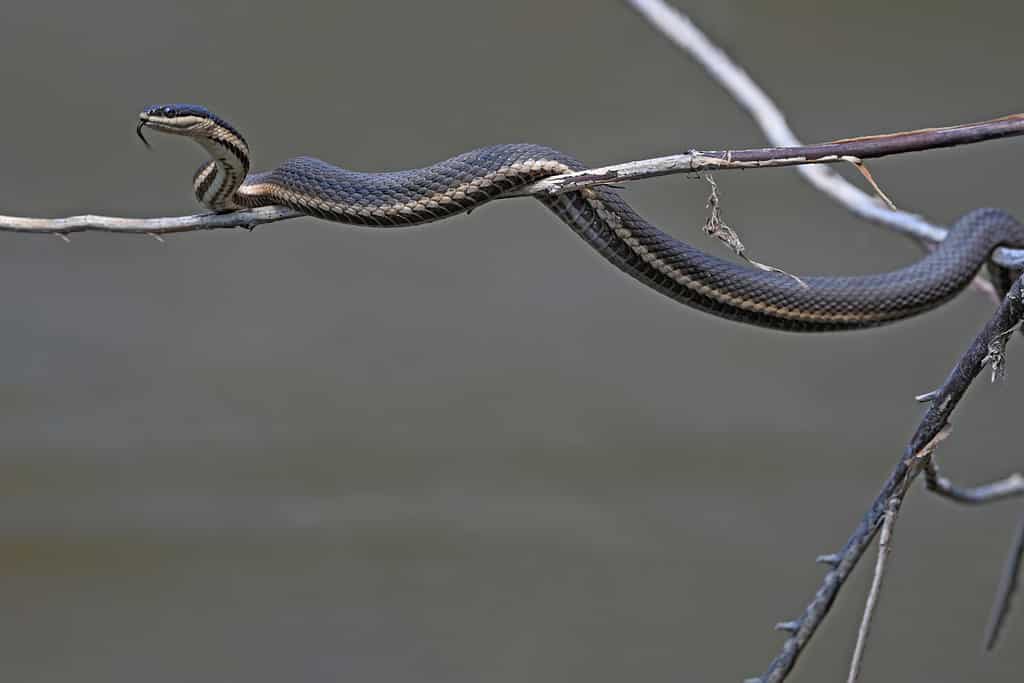
Although semiaquatic, queensnakes come out to bask and mate.
©Lev Frid/Shutterstock.com
Hiding in the shallows most of the time, queensnakes almost exclusively eat crayfish. They only rarely eat other prey, and only when they have no crayfish available.
Queensnakes are nonvenomous and seem to have good enough sight for hunting, in addition to their sense of smell. To find these snakes around Lake Anna, keep an eye on the water’s edge, where crayfish lurk. Chances are, you’ll see a queensnake hunting them.
Eastern Copperhead (Agkistrodon contortrix)
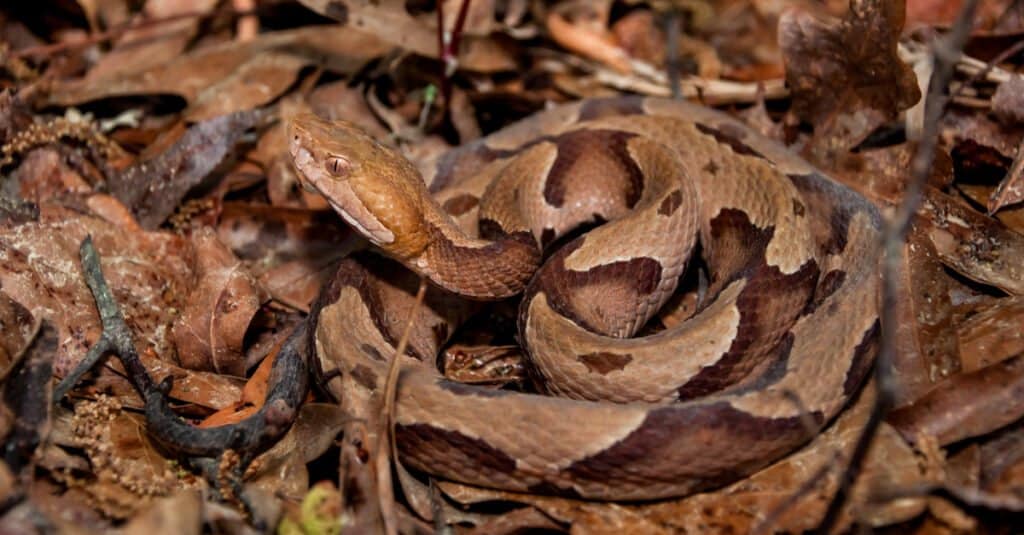
A copperhead blends in so well that people don’t always see them.
©Jay Ondreicka/Shutterstock.com
The only venomous snake around Lake Anna is shy and not aggressive. However, copperhead snakebites account for about half of the 7,000 to 8,000 venomous snakebites in the U.S. annually.
Copperheads’ chocolate kiss-like patterns are the perfect camouflage for the forest floor where they make their home. They tend to stay on paths instead of in the water – they’re notorious for basking in the middle of walkways. Unlike other snakes, copperheads freeze in place. These snakes are hard to spot on a path covered with leaves and people step on them without seeing it. These venomous pit vipers are on the smaller side, only growing to about three feet long. Copperheads eat a variety of small prey, including small rodents, arthropods, and lizards.
Venomous Snakebite First Aid
Of the 7,000 to 8,000 venomous snakebites in the U.S. annually, only about five are fatal. So even though it is frightening, most people survive and recover fully when they get early care. Here’s what you should do in case of a copperhead snakebite.
- Keep the victim calm! The more stressed or frightened they become, the faster and farther the venom can travel.
- Call 911 for help or get to a hospital. If your pet was bitten, call your vet for advice.
- Clean the bite wound with soap and water, then cover with a clean bandage. There’s no reason to add an infection to an already bad situation.
- Remove all watches, jewelry, restrictive clothing, and shoes.
- Keep the body part below the level of the heart and immobilized, if possible.
- Take photos or memorize the details of the snake.
In case you wondered, there are a few things you should never do.
- NEVER cut the wound and try to suck out the venom.
- DO NOT try to capture the snake. If the first bite was a warning, the second will be the real deal.
- DO NOT take aspirin, alcohol, or other substances that thin the blood or impair judgment.
- DO NOT use a tourniquet. They isolate venom to that particular limb. While that might seem useful, with hemotoxic and cytotoxic venoms like most of our U.S. venomous snakes possess, you wind up with greater damage that your body can’t fix completely. There are other treatment complications, but you get the idea.
Other Animals Around Lake Anna
Lake Anna’s roughly 200 miles of shoreline give wildlife plenty of places to make a home. In addition to the various snakes, here are a few animals you may see as you hike or boat near the lake.
- Slender Glass Lizard (Ophisaurus attenuatus) — not all legless reptiles are snakes.
- White-tailed deer (Odocoileus virginianus) — also called the Virginia deer, this species is native to the Americas as far south as Peru.
- Eastern box turtle (Terrapene carolina) — Although it is primarily terrestrial, box turtles are more closely related to turtles than tortoises.
- Common Raccoon (Procyon Iotor) — These lovable thieves make themselves at home just about anywhere!
Who to Call for Help with an Animal
With 200 miles of coastline, Lake Anna has numerous camping, fishing, and boating areas. You are bound to encounter an animal somewhere! While most animals only want to be left alone, some may become aggressive, especially during breeding season.
Rangers local to the area you are currently exploring will be best able to help with wildlife encounters. The Virginia Department of Wildlife Resources has a convenient list of contact information for questions about Lake Anna.
If you happen to be a resident, local animal control agencies are authorized to handle nuisance wildlife, but they often do not have the personnel to deal with anything more than domestic animals like dogs and cats. So, your best bet is to contact a local rehabber or licensed animal trapper to take care of any problem animals.
The photo featured at the top of this post is © ButtermilkgirlVirginia/Shutterstock.com
Discover the "Monster" Snake 5X Bigger than an Anaconda
Every day A-Z Animals sends out some of the most incredible facts in the world from our free newsletter. Want to discover the 10 most beautiful snakes in the world, a "snake island" where you're never more than 3 feet from danger, or a "monster" snake 5X larger than an anaconda? Then sign up right now and you'll start receiving our daily newsletter absolutely free.
Thank you for reading! Have some feedback for us? Contact the AZ Animals editorial team.







